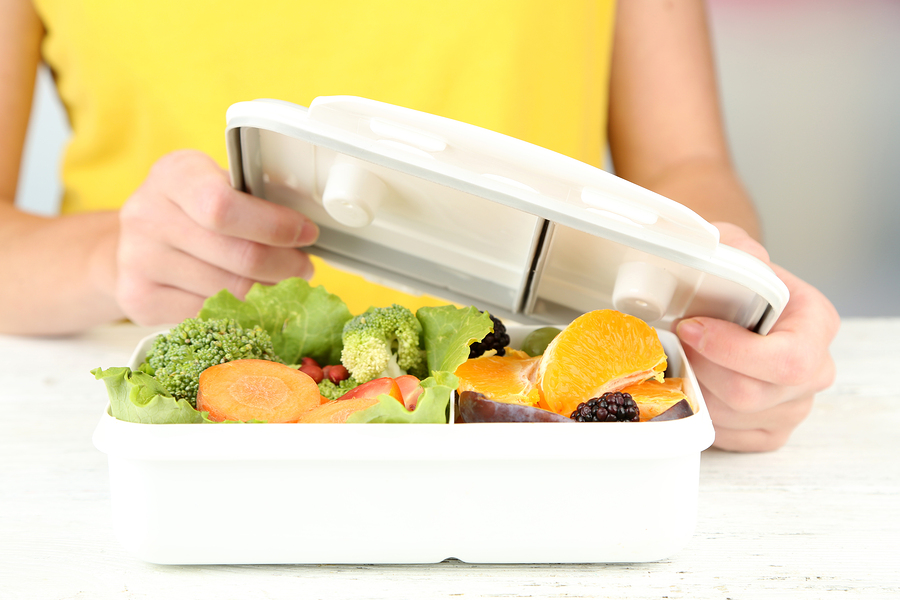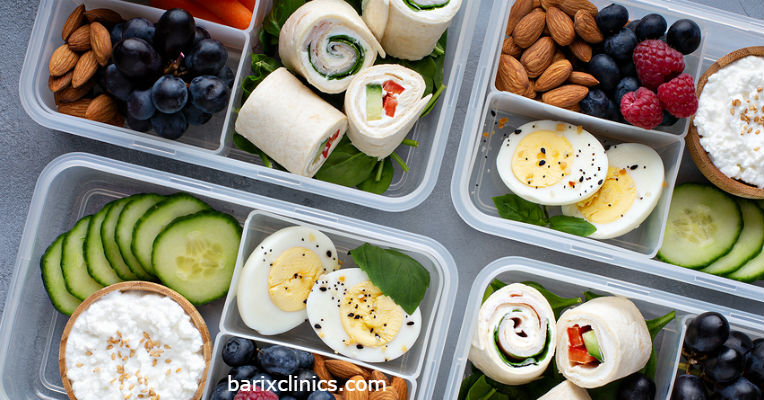Do you have room for improvement when it comes to healthy eating? If so, food prep may help get you there. Start small, learn the ropes, and you’ll be a pro in no time.
There are lots of ways to work ahead to minimize your daily meal prep effort. Use these ideas to get your creative juices flowing.

Download On Track with Barix: Food Prep to Eat Better and Simplify Your Life
- Make-ahead meals. Prepare and cook complete meals, then store in bulk to reheat.
- Put single-serving snack, lunch, or dinner portions in containers for grab-and-go convenience.
- Meals for one. Prepare and portion entire meals into single-serving containers.
- Assemble meals (don’t cook), refrigerate or freeze to cook later.
- Ingredient prep. Chop vegetables, marinate meat, and portion out spices to minimize daily cooking time.
- Cook once and make several different meals. Lean ground beef can be spaghetti sauce Monday night, tacos on Tuesday, and chili on Wednesday.
The benefits to food preparation are numerous:
- It puts you in control of the foods you cook. You can limit salt, added sugars, and saturated fat and serve right-sized portions.
- You’ll save money. Preparing food at home minimizes more costly meals out. By planning and prepping, you will waste less food.
- You’ll save time. There’s no need to wait in a drive-thru line. Cooking is a breeze when you’ve planned and prepped.
- You’ll be less stressed. One less thing on your plate – tell me that doesn’t sound good?
- You’ll eat better. Having healthy foods readily available makes it easy to make a good choice. After all, we all tend to do what is easiest at the moment.
- It appears that all of this healthy home eating is good for the entire family. Teens that eat at home with their families are less likely to smoke, drink, or use drugs. They also get higher grades and have better-eating habits as adults. Younger children are more likely to eat fruits, vegetables, and whole grains.

How to start:
To garner the benefits of food prep, start with a meal plan, a shopping list, food storage containers, and a couple of hours each week.
It can be overwhelming to go from winging it to planning all your meals and snacks. You may want to start with one meal first. You’ll undoubtedly get benefits by taking this first step and then building on your successes. Keeping it simple will also help. Repeat meals, use tried-and-true recipes or simple recipes without many ingredients.
Step 1: Meal Planning
Pencil in meals on your calendar (or find an app to use), gather recipes and make a list of ingredients needed week-by-week for an entire month. You may want to use the Barix Clinics Meal Planning Guidelines to make a meal plan. Once you do this, it is easy to tweak from month to month to accommodate seasonal foods and add variety.
Step 2: Stock up on Food Storage Containers
Food storage containers come in various sizes, shapes, and materials. Find the right containers for your food prep style.
- The sizes you select will depend on your needs.
- Are you prepping meals for one or a large family?
- Do you plan to portion out snacks or buy single-serving containers?
- What shapes do you want? Round containers work well for soups. Rectangle containers fit more compactly into the fridge or freezer.
- If you have limited storage spaces, look for empty containers that nest for storage?
- Some food prep containers come with dividers to keep foods separate.
- Food storage containers are typically made of plastic or glass. Plastic containers are lighter and don’t break easily. They are not typically recommended for the microwave. If you are going with glass, ensure the containers are freezer and microwave safe. Containers should have leak-proof lids.
- Food storage bags can be a good option. They work great if you like to buy in bulk and then portion nuts and other snack foods into single servings. Freezer bags are thicker and help to keep frozen foods fresh longer.
- Vacuum sealed. Food exposed to air oxidizes and does not stay fresh. A vacuum sealer removes air, creates a tight seal, and keeps foods fresh longer. Both bags and containers come in vacuum seal versions. Bags are typically not reusable; containers are.

Step 3: Grocery Shop
Once you have a meal plan in place, it’s easy to put together a shopping list. With a list in tow, you can minimize impulse buying. Ordering online for pick-up or delivery can also help you stick to your grocery list.
Step 4: Weekly Meal Prep
You have a plan, containers, and groceries. Now it’s time to prep. Make it fun by cranking up the tunes and enlisting the help of family or friends.
You don’t have to make an entire week’s worth of meals at one time. Instead, you may want to do an extensive prep on the weekend and a smaller prep halfway through the week. Most foods keep safely in the refrigerator for 3-5 days.
If you want to start slower, chop vegetables and cook a batch of chicken in the slow cooker. Even these simple steps will ease your work week load.
If you decide to go all-out, you can:
- Pre-cook breakfast for the week (egg bites or protein pancakes, for example)
- Portion out (but not assemble) deli meat, bread, and toppings for lunch sandwiches
- Portion out snacks, and prepare dinners to reheat
Once you get in the groove, meal prep is definitely doable. Start big or start small – just start.

